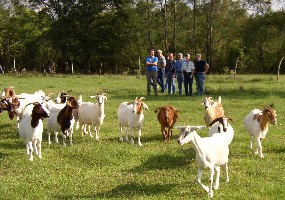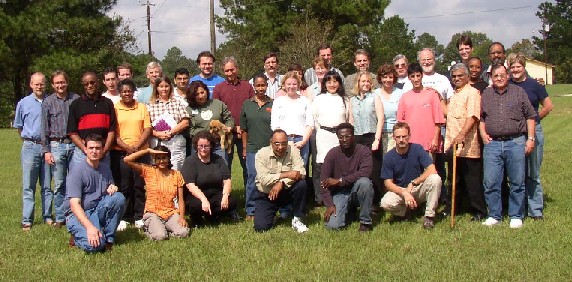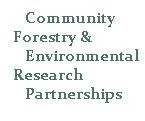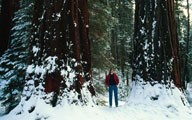|
2002 - 6th Annual CFERP Workshop - Alabama

The 6th annual CFERP workshop was held from October 9-12, 2002 , at the Federation of Southern Cooperatives in Epes , Alabama . The goal of the workshop was to help develop a broader understanding of the theoretical and substantive issues in community forestry and participatory research among workshop participants, to provide networking opportunities, and to expand the institutional connections and networks of the CFERP program. That the workshop exceeded these goals was evident in the renewed energy and enthusiasm for community forestry that the participants carried away from the meeting with them. This enthusiasm was captured in a review of the workshop by a participant who wrote “the Community Forestry Research Fellows Program continues to serve as a key dimension to the growing network of CF practitioners, policy makers and analysts, and researchers in the United States .”
Forty people attended this year’s workshop including many new and returning special guests. The special guests were invited to further expand CFERP networks, to engage professionals and community people in the Southeast in the ongoing dialogue about community forestry and participatory research, and to nurture links to Historically Black Colleges and Universities. They were
- John Schelhas, Forest Service liaison, Tuskeegee University
- Casandra Johnson, sociologist, USDA Forest Service, Athens , Georgia
- Rory Fraser, Professor, Alabama A&M University
- Rosalind Peoples, cooperator in goat agroforestry, Alabama
- S.B. Roy, Indian Institute of Bio-social Research and Development
- Paul Dunn, Director, Small Business Development Center , University of Louisiana at Monroe
- Sara Crim, student, Auburn University
- Buddhi Gyawali, student, Alabama A&M University
Like the 2001 workshop, the 2002 workshop opened with a half-day session on participatory research (PR). This year the PR mini-workshop was led by Shanna Ratner and Debra Mason of the National Community Forestry Center ’s Northern Forest Regional Center. The session helped fellows and their community partners better understand what PR is, and understand that there are many levels of community involvement at all stages of the research process.
John Isom, 2001 predissertation fellow and 2002 dissertation fellow, wrote a review of the 2002 workshop for the World Rainforest Movement (Uruguay ) Newsletter. The excerpt from his review below is a good summary of the fellow/community partner presentations which formed the core of the workshop.
The projects of the graduate student fellows provide the focal point of discussion and collaboration on CF. This year’s research topics again ranged across the four kinds of lands in which CF can and should take place in the United States : publicly owned and administered, private lands, Native American lands, and urban lands. Topics also covered a representative regional focus of CF concerns in the United States .
This year’s topics demonstrated the range of concerns that CF examines. Of particular interest were projects that are examining race relations, temporary guest workers, and the invisibility of some communities. A second topic examined the relationships between poverty and industrial forest extraction, a relationship summed up by a participating professor in the compelling question: do trees cause poverty? Three papers dealt explicitly with social networks in resource access and management. And, as part of a “New Directions” session, two papers demonstrated how rigorous science can serve the social-movement dimension that has long been the foundation of CF and social change. Woman, health, and access to resources and the need to use history in CF rounded out the presentations.
These papers and the presentations by graduate fellows and their community partners provided the framework for more extensive discussions. Recurring themes during the four-day workshop included issues of power, access and control in the context of multi-stakeholder environmental governance, the role of place, identity and access (who is in place and who is out of place), the roots of boundaries and mistrust, and again, race relations and invisible communities.
A field trip focusing on issues in private forestry in Alabama was also part of this year’s workshop. It included a brief orientation to issues confronting small forestland owners in Alabama ’s black belt, and a short tour of the Federation’s demonstration projects in agroforestry through which it is attempting to address some of these issues. The tour also included a trip to one of the cooperators in the Federation’s agroforestry program where the group toured the cooperator’s goat raising operation, honey production operation, and small woodlot. The day concluded with an evening discussion with the cooperator and his wife about their operation as well as about race relations in Alabama .

|







